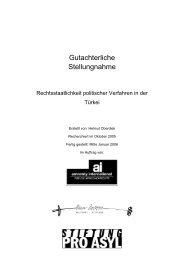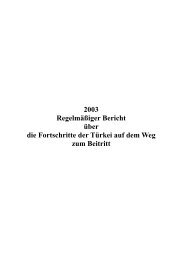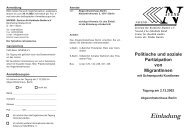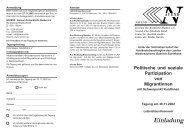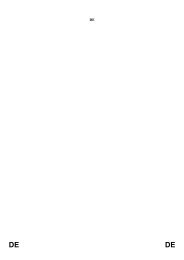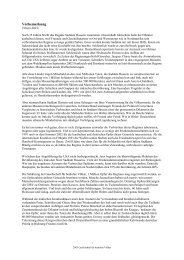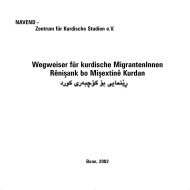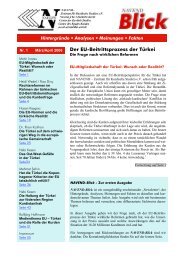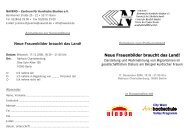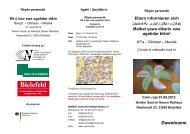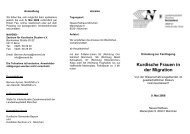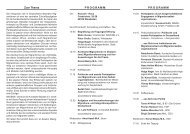Responsibility to protect the Kurds - Navend
Responsibility to protect the Kurds - Navend
Responsibility to protect the Kurds - Navend
Create successful ePaper yourself
Turn your PDF publications into a flip-book with our unique Google optimized e-Paper software.
<strong>Responsibility</strong> <strong>to</strong> <strong>protect</strong> <strong>the</strong> <strong>Kurds</strong><br />
March 2003<br />
The report quotes also <strong>the</strong> Chairman of<br />
<strong>the</strong> Department of Medicine of<br />
Suleymania University Dr. Fouad Baban<br />
in order <strong>to</strong> describe <strong>the</strong> effect of <strong>the</strong><br />
mustard gas and nerve agents in relation<br />
<strong>to</strong> similar attacks. Dr. Baban has said that<br />
Halabja’s congenital abnormality rates<br />
‘are four <strong>to</strong> five times greater than in <strong>the</strong><br />
post-a<strong>to</strong>mic populations of Hiroshima and<br />
Nagasaki. Rates of stillbirths and<br />
miscarriages in <strong>the</strong> <strong>to</strong>wn are even more<br />
alarming. Rare and aggressive cancers in<br />
adults and children are found at levels far<br />
higher than anywhere in <strong>the</strong> world.’ 1<br />
With <strong>the</strong> fresh memories of Halabja and<br />
Anfal operations, and with repeated US<br />
officials referring <strong>to</strong> what Saddam<br />
Hussein’s regime may possess even<br />
now, <strong>the</strong> fear of <strong>the</strong> <strong>Kurds</strong> are far from<br />
being exaggerated. If <strong>the</strong> figures are near<br />
<strong>to</strong> any truth about <strong>the</strong> following elements<br />
of Iraq’s weapons of mass destruction,<br />
<strong>the</strong> threat against <strong>the</strong> <strong>Kurds</strong> must be<br />
considered real ra<strong>the</strong>r than potential. Iraq<br />
has declared 8,500 litres of anthrax, but<br />
<strong>the</strong> UN estimate is 26,000 litres; Iraq has<br />
declared 19,000 litres of botulinum <strong>to</strong>xin,<br />
but eh UN estimate is 38,000 litres; Iraq’s<br />
1.5 <strong>to</strong>ns of VX nerve gas remains<br />
unaccounted for; Iraq’s more than 30,000<br />
munitions, shells and bombs remain<br />
unaccounted for; Iraq possesses more<br />
than 100 missiles exceeding 150<br />
kilometres; Iraq’s possession of 5,500<br />
litres of afla<strong>to</strong>xin (a carcinogen) and 550<br />
artillery shells filled with mustard agent. 2<br />
1 US State Department, 2003, Apparatus of lies.<br />
Saddam’s disinformation and propaganda, 1990-<br />
2003, p. 18-19.<br />
2 Iraq’s hidden weapons: Failing <strong>to</strong> disclose and<br />
disarm, available at www.state.gov; White House,<br />
‘Global message on Iraq’, 5 th March, 2003, at<br />
http://www.whitehouse.gov/infocus/iraq/global_20<br />
030305.html<br />
7<br />
As a White House document stated in<br />
March, <strong>the</strong> ‘danger posed by Saddam<br />
Hussein and his weapons cannot be<br />
ignored or wished away.’ 3 In that context<br />
<strong>the</strong> <strong>Kurds</strong> can hardly feel secure without<br />
being offered any real <strong>protect</strong>ion when<br />
<strong>the</strong>y also hear president Bush saying that<br />
after 12 years UN sanctions and<br />
inspections Saddam Hussein has<br />
systematically violated all agreements<br />
and sanctions, and that:<br />
He pursued chemical, biological, and<br />
nuclear weapons, even while<br />
inspec<strong>to</strong>rs were in his country.<br />
Nothing <strong>to</strong> date has restrained him<br />
from his pursuit of <strong>the</strong>se weapons --<br />
not economic sanctions, not isolation<br />
from <strong>the</strong> civilized world, not even<br />
cruise missile strikes on his military<br />
facilities. 4<br />
Much of what has been stated in ano<strong>the</strong>r<br />
US State Department report could be true<br />
under <strong>the</strong> prevailing circumstances. The<br />
vulnerability of <strong>the</strong> Kurdish civilians now<br />
does not differ very much from that of <strong>the</strong><br />
inhabitants of Halabja, or <strong>the</strong> rest of <strong>the</strong><br />
Kurdish population for that matter, during<br />
Iraq’s chemical attacks. At that time, <strong>the</strong><br />
<strong>to</strong>wn of Halabja ‘had <strong>the</strong> misfortune of<br />
being on <strong>the</strong> front lines of <strong>the</strong> Iran-Iraq<br />
war’ says <strong>the</strong> State Department report. 5<br />
The inhabitants, who numbered<br />
50,000 or more at <strong>the</strong> time, knew <strong>the</strong><br />
hard realities of conventional war<br />
firsthand, but <strong>the</strong>y had no preparation<br />
3 White House, ‘Global message on Iraq’, 5 th<br />
March, 2003, at<br />
http://www.whitehouse.gov/infocus/iraq/global_20<br />
030305.html<br />
4 State of <strong>the</strong> Union Address by President George<br />
W. Bush, 28 th January 2003, available at<br />
http://www.whitehouse.gov/news/releases/2003/0<br />
1/print/20030128-19.html<br />
5 US State Department, December 2002, Iraq<br />
from fear <strong>to</strong> freedom, p. 3.



